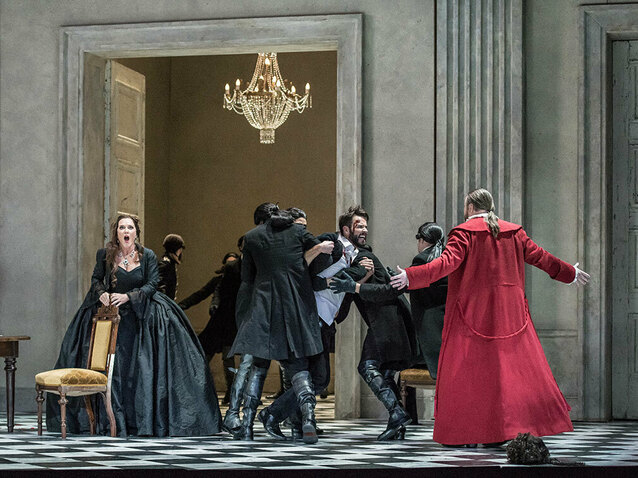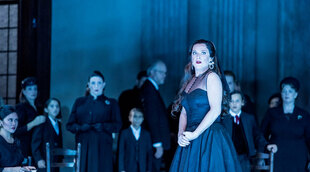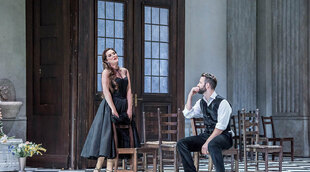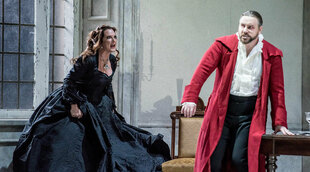 © Genevieve Girling
© Genevieve Girling
Based on Victorien Sardou’s 1887 French-language play, Giacomo Puccini’s Tosca of 1900, with a libretto by Luigi Illica and Giuseppe Giacosa, occurs on a precise date that can be linked to an historical event. All of the action takes place during the afternoon, evening and early morning of 17 and 18 June 1800, following the Battle of Marengo between Napoleon’s army and Austrian forces. The Austrians were initially triumphant and sent news of victory back to Rome, but the city’s celebrations were cut short when a later report revealed that Napoleon had subsequently mustered reinforcements and actually inflicted a crushing defeat.
Tosca is set across the hours when the contradictory messages arrive in Rome. Angelotti, a consul of the city when it was a republic but a prisoner since Neapolitan forces began to occupy it, escapes from the Castel Sant’Angelo and turns to the painter Cavaradossi to hide him. Rome’s Chief of Police, Baron Scarpia, attempts to squeeze information as to Angelotti’s whereabouts from Cavaradossi’s lover, the celebrated singer Floria Tosca. She is naturally prone to jealousy and Scarpia exploits this, as well as the situation as a whole in order to fulfil his own love for her.
After Scarpia sentences Cavaradossi to death for harbouring a fugitive, Tosca promises the Chief to give herself to him if she will release her lover and allow both of them to leave Rome. Scarpia agrees, explaining that he still needs to appear to have killed Cavaradossi, and so (apparently) instructs his agent to stage a mock execution, after which they can both escape. As soon as Scarpia has written out their passport, however, Tosca stabs him to death. At the subsequent execution Tosca discovers all too late that Scarpia tricked her, and that Cavaradossi was shot with real bullets. As news of Scarpia’s murder spreads Tosca leaps off the parapet of the Castel Sant’Angelo and plunges to her death.
Given the specific nature of the background events, few directors choose to set the opera in anything other than its original time and place. Exceptions to this rule include Luc Bondy’s 2009 production for the Metropolitan Opera, which saw Richard Peduzzi’s sets imply a setting of 1930s fascist Italy, but beyond this did nothing to say we were not in the midst of the French Revolutionary Wars. Christof Loy in his new production for English National Opera, which comes from The Finnish National Opera and Ballet where it appeared in 2018, similarly opts for the original setting while also applying a slight twist. He puts the characters in costumes from a variety of eras, which universalises the opera’s messages and shows how there have been Scarpias exploiting Toscas at all moments in time. Loy also does this to highlight the division between Cavaradossi’s revolutionary ideals and Scarpia’s reactionary approach. The former dons a 1950s suit, while aristocrats appear in lavish late eighteenth century costumes as if they have just come out of a traditional production of Le nozze di Figaro.
Loy and designer Christian Schmidt endeavour to make the atmosphere feel very real and hence relatable. In this way, the interior of Sant’Andrea della Valle, the setting for Act I, appears quite modest and suggests that people continuously come and go from the church as Angelotti narrowly avoids a woman who is in there when he enters. However, in introducing further characters to make things seem more plausible several problems arise. It does not matter that the introduction of this woman and an assistant to Cavaradossi create too many opportunities for leaks regarding Angelotti’s whereabouts as there would always be the possibility of these. However, when the Sacristan addresses a line to the youth rather than Cavaradossi, or Cavaradossi to him as opposed to Angelotti, it fractures the dynamic when it needs to be kept focused and tight. The addition of supernumeraries in Act II works much better as we see a whole torture team march in with briefcases, making their clinical approach to their profession feel highly chilling. However, having Act III’s Jailer witness Tosca’s discovery that Cavaradossi is dead breaks the tension because it diffuses the sense of horror she feels by showing how others share in it. This is a shame as the part is sung very well by Ronald Nairne who also shows him to be a kindly figure by refusing the ring that Cavaradossi offers to take a letter to Tosca.
Overall, the attempts to heighten the realism meet with mixed results. Revealing just how brutal Scarpia is by seeing him frequently manhandle Tosca works, but having him grasp her at the start and end of ‘Vissi d’Arte’ mars the singer’s ability to ‘go solo’ and make this most emotive of arias stand as a vortex at the centre of the storm. This said, when Tosca does step away from him during the piece we can see just how infatuated he is with her as he looks completely broken. In Act I, the attempts to make Cavaradossi and Tosca’s relationship feel believable by frequently seeing them kiss and embrace leads to some of the actions feeling rather basic or even hammed. While having people witness Scarpia’s ‘soliloquy’ during the ‘Te Deum’ (as opposed to placing him alone) emphasises just how much he has been disarmed by Tosca, it stretches credulity that he would writhe on the floor as he does here in front of others. The shooting of Cavaradossi also feels a little aimless because the staging does not match the ‘marching on’ and ‘marching off’ music. In fact, notwithstanding the distraction of the Jailer’s presence, the whole ending almost focuses too much on Tosca’s own feelings. That is not something one would normally think was possible, but the drama as a whole seems to be rather unfocused and hence lacking as her final jump over the parapet is delayed to the final note when normally it comes a few bars earlier.
In the title role Sinéad Campbell-Wallace, seen here as Mimì in La bohème last February, gives a very full-blooded performance as she asserts her excellent soprano with frequently thrilling results. There is also a great level of detail in her interpretation so that when in Act II Cavaradossi asks Tosca if she told Scarpia anything and she lies and says she did not, her glance to the Chief of Police not to give her away is plain for all to see. As Cavaradossi, Adam Smith asserts his brilliantly expansive tenor to breathtaking effect so that ‘Recondita armonia’ and ‘E lucevan le stelle’ are two of the undoubted highlights of the evening. On opening night Noel Bouley was unable to sing the role of Scarpia but acted it while Roland Wood sang from the side, and rarely has such a ‘partnership’ worked so well. Wood sounded fabulous, but Bouley played his part to the full by still feeling a formidable presence (his first entrance was particularly well executed) and shaping every single word as if he were actually singing. This is not easy when one is producing no sound, and not all performers manage to do it, but there were occasions when it was easy to forget there was not just one person performing, which is a credit to both men.
Conductor Leo Hussain delivers a strong and focused account of the score, while there is superb support from Msimelelo Mbali as Angelotti, Lucia Lucas as the Sacristan, John Findon as Spoletta and Ossian Huskinson as Sciarrone. Matilda McDonald produces an especially good sound as the Shepherd Boy, only here she is nothing of the sort. Instead, the character is dressed like Tosca so that it is as if she appears and sings to Cavaradossi in a dream while he awaits his execution. It is moments like this that remind us that, although not every idea in this production works in the way that was surely intended, there are still a great many that really hit the mark. Richard Farnes conducts on 2 and 4 November and Aled Hall plays Spoletta on 27 and 29 October.
By Sam Smith
Tosca | 30 September – 4 November 2022 | London Coliseum
the 02 of October, 2022 | Print



Comments